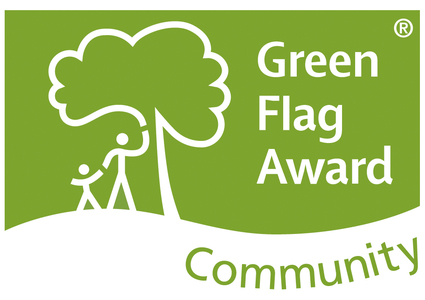Site Description and History
The main area of the site is a central green space used mostly as a children’s play area, for picnics and as a community meeting place. This is surrounded by mature and more recently planted trees and shrubs. The south-east corner has been set aside as a wild area with unmown grass interspersed with trees. A strip of turf was removed in 2011 for planting with wild flower seeds, and the turf used to patch the main grass area where it had been worn by young footballers. The southern border is characterised by denser planting to shield the site from the adjacent railway line and includes a woodland path to the west. Recycling and composting facilities have been set up along the northern border.
A botanical survey, carried out in 2006-2007, identified a large number of native species. To build on the existing stock of fruit trees, new plantings focus on edible and native plants, which provide a handy food source for neighbours. Trees include two varieties of apple, crab apple, quince, damson, mulberry, rowan and walnut. Several new trees were planted in 2011: a pear, purchased by the Friends, in the wild area; and cherry, black walnut, damson and Victoria plum, supplied and planted by the Council in consultation with FSHLO.
We have introduced herbs, including a bay tree donated by a local councillor. In 2009-10 a spring bulb and herb bed was laid along the western path. This was supplemented in 2011 with lavender plants to add fragrance as people pass.
As well as being a focal point for local residents, the Orchard provides a convenient and pleasant route for pedestrians, dog walkers and cyclists due to its situation between two cul-de-sacs and proximity to a railway footbridge leading to Bushy Park. Unsightly chainlink gates were removed, the path resurfaced and entrance signs installed by the Council in consultation with FSHLO in 2007 to make the site more welcoming and accessible. In addition, grant funding was used to purchase and install two benches. These measures have resulted in a significant increase in regular daily visitors.
To replace rusty, broken chainlink fencing, dead and live hedging was installed along the main west and north borders in 2010 by FSHLO with guidance from the British Trust for Conservation Volunteers. This project was filmed by a local professional lighting cameraman. The film can be seen on the Teddington and Hampton 2010 website, recording key events in these towns during the year, and on YouTube. The live hedging consists of a variety of native plants, building on the ‘edible’ theme by including blackthorn and hazel. The dead hedge provides a useful community recycling facility, a wildlife habitat, and is far more attractive than its predecessor! The northern dead hedge was completed in 2011, except for the western corner (to allow a dead tree to be removed and replaced with a new black walnut).
Measures to encourage wildlife include our focus on planting native and edible species, the dead hedge, bird boxes and a log pile. Wildlife includes various garden and woodland birds (nuthatches, goldfinches and greater spotted woodpeckers were amongst those seen in 2011), pipistrelle bats, foxes and the occasional visit by a tawny owl.
In 2012 we began to experiment with the creation of a wild flower meadow in the wild area. We expanded the dead hedging in the north-west corner.
Site Management and Maintenance
Volunteers meet monthly on Saturday mornings between March and November and at other times on an ad hoc basis to carry out practical work as required. This mostly involves planting, pruning, tidying and mowing.
We compost, recycle and re-use green waste and other rubbish as much as possible, via leafmould production, compost bins, the dead hedge and Council recycling collections. Two large compost bins are available.
The group works closely with the South-West London Environment Network (SWLEN), Richmond Council and The Conservation Volunteers (TCV).
A membership scheme to raise funds and attract more volunteers was launched in 2009.
Finance is provided by the Council, grant organisations (see below) and fund-raising activities by FSHLO, including the summer party and membership scheme. In addition, local residents have donated funds, equipment and plants. A good range of tools has been purchased using the grant income, as well as a shed for secure storage of tools and equipment.
The FSHLO publicises the Orchard, events and activities via its website, email mailing list, occasional newsletters and fliers distributed to surrounding houses. A Friends noticeboard is near the School House Lane entrance.

